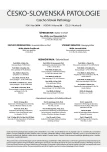Myxoidní varianta epiteloidního maligního mezoteliomu peritonea. Popis případu.
Authors:
Barbara Goldová 1; Pavel Dundr 1; Michal Zikán 2; Věra Tomancová 3
Authors‘ workplace:
Department of Pathology, First Faculty of Medicine and General University Hospital, Charles University in Prague, Czech Republic
1; Oncogynecological Centre, Department of Obstetrics and Gynecology, First Faculty of Medicine and General University Hospital
Charles University in Prague, Czech Republic
2; Department of Oncology, First Faculty of Medicine and General University Hospital, Charles University in Prague, Czech Republic
3
Published in:
Čes.-slov. Patol., 50, 2014, No. 3, p. 149-151
Category:
Original Article
Overview
Myxoidní varianta difuzního epiteloidního maligního mezoteliomu je vzácná. Ke dnešnímu datu byly popsané pouze tři případy tohoto typu mezoteliomu, který postihoval peritoneum. Přestože jde o vzácný tumor v peritoneální dutině, měl by být zahrnutý do diferenciální diagnózy myxoidních / mucinózních břišních lézí, které myxoidní MM můžou imitovat. Uvádíme případ 60-ti leté pacientky s myxoidní variantou maligního mezoteliomu peritonea. Histologicky nádor sestával ze středně velkých až velkých epiteloidních buněk se středním až hojným množstvím eosinofilní cytoplasmy. Některé z buněk obsahovali intracytoplasmaticky opticky prázdné vakuoly. Jádra buněk byla nepravidelná s hrubým chromatinem, některá obsahovala prominentní jadérka. Některé z buněk byly vícejaderné. Mitózy byly patrné řídce. Většina buněk byla rozprostřená na myxoidním pozadí. Imunohistochemicky nádorové buňky vykazovali difuzní pozitivitu koktejlu cytokeratinů AE1/AE3, kalretininu, D2-40 a cytokeratinu 7. Vimentin, HBME- 1 a WT-1 byly pozitivní jen fokálně. Progesteronové receptory vykazovali pozitivitu v ojedinělých buňkách (do 5%). Ostatné vyšetřované markery jmenovitě cytokeratin 20, estrogenové receptory, BerEP4, CEA, TTF-1, GCDFP-15 a CD15 byly negativní.
Klíčová slova:
maligní mezoteliom – myxoidní varianta – peritoneum
Sources
1. Shin MK, Lee OJ, Ha CY, Min HJ, Kim TH. Malignant mesothelioma of the greater omentum mimicking omental infarction: A case report. World J Gastroenterol 2009; 15(38): 4856-4859.
2. Yang GZ, Li J, Ding HY. Localized malignant myxoid anaplastic mesothelioma of the pericardium. J Clin Med Res 2009; 1(12): 115-118.
3. Cabay RJ, Siddiqui NH, Alam S. Paratesticular papillary mesothelioma: A case with borderline features. Arch Pathol Lab Med 2006; 130(1): 90-92.
4. Baker PM, Clement PB. Malignant peritoneal mesothelioma in women. A study of 75 cases with emphasis on their morphlogic spectrum and differential diagnosis. Am J Clin Pathol 2005; 123: 724-737.
5. Shia J, Qin J. Malignant mesothelioma with a pronounced myxoid stroma: a clinical and pathological evaluation of 19 cases. Virchows Arch 2005; 447(5): 828-834.
6. Diaz LK, Okonkwo A. Extensive myxoid change in well-differentiated papillary mesothelioma of the pelvic peritoneum. Ann Diagn Pathol 2002; 6(3): 164-167.
7. Soltermann A, Pache JC, Vogt P. Metastasis of a pleural mesothelioma to a hyperplastic stomach polyp: an increase of vimentin expression is seen during a gain in deciduoid morphology. Rare tumors 2011; 3(4): 52.
8. Shao ZH, Gao XL, Yi XH, Wang PJ. Malignant mesothelioma presenting as a giant chest, abdominal and pelvic wall mass. Korean J Radiol 2011; 12(6): 750-753.
9. Fonte R, Gambettino S. Asbestos- Induced peritoneal mesothelioma in a construction worker. Environmental Health Perspectives 2004; 112(5): 616-619.
10. Leslie KO, Wick MR. Practical pulmonary pathology (2nd edn). Philadelphia: Elsevier Saunders; 2011: 728- 734.
11. Ordóñez NG. Pleomorphic mesothelioma: report of 10 cases. Mod Pathol 2012; 25(7): 1011-1022.
12. Ordóñez NG. The diagnostic utility of immunohistochemistry and electron microscopy in distinguishing between peritoneal mesotheliomas and serous carcinomas: a comparative study. Mod Pathol 2006; 19(1): 34-48.
13. Yaziji H, Battifora H. Evaluation of 12 antibodies for distinguishing epithelioid mesothelioma from adenocarcinoma: identification of a three-antibody immunohistochemical panel with maximal sensitivity and specificity. Mod Pathol 2006; 19(4): 514-523.
14. Ordóñez NG. The immunohistochemical diagnosis of mesothelioma: a comparative study of epithelioid mesothelioma and lung adenocarcinoma. Am J Surg Pathol 2003; 27(8): 1031-1051.
15. Hirano H, Fujisawa T. Malignant mesothelioma of the peritoneum: case reports and immunohistochemical findings including Ki-67 expression. Med Mol Morphol 2010; 43(1): 53-59.
16. Jarvinen K, Soini Y. Overexpression of gamma-glutamylcysteine synthetase in human malignant mesothelioma. Hum Pathol 2002; 33(7): 748-755.
17. Loggie BW, Fleming RA. Prospective trial for the treatment of malignant peritoneal mesothelioma. Am Surg 2004; 67(10): 999-1003.
18. Allen TC, Cagle PT. Localized malignant mesothelioma. Am J Surg Pathol 2005; 29(7): 866-873.
Labels
Anatomical pathology Forensic medical examiner ToxicologyArticle was published in
Czecho-Slovak Pathology

2014 Issue 3
Most read in this issue
- Intestinální metaplazie žaludku a jícnu: imunohistochemická studie 60 případů včetně porovnání expresí hlenů v normální a zánětlivě změněné sliznici střeva
- Nádory měkkých tkání očima molekulárního patologa
- Přehled dosavadních zkušeností s mezinárodní klasifikací tenkojehlové aspirační cytologie štítné žlázy Bethesda 2010
- Komplexní přístup v diagnostice lymfomů v praktických příkladech
